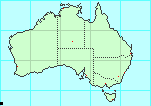
Common Name:
Delete this section if there is no common name.
Identification:
Length:
Coloring:
Note any distinguishing features.
volant and mesopterous, female brachypterous
 Note parental placement of eggs.
Note appearance of eggs.
Note any common variations.
Note parental placement of eggs.
Note appearance of eggs.
Note any common variations.
Habitat:
Note if the species arborial or terrestrial.
Canopy, mid, under, etc.
Note typical vegetation, e.g.
tropical rainforest, temperate rainforest,
grasslands,
alpine, etc.
Similar Species:
Rearing Notes:
Note if this species has ever been reared.
Note any suggestions for successful rearing.
For a stick insect with body length 169mm, to keep 2 adult females,
you need a cage at least 750mm high, 350mm deep and 350mm wide.
 Range:
Range:
known only from type locality
Status:
It is not known if this species is endangered,
as there is insufficient sighting history.
References:
-
Balderson, J., Rentz,
D.C.F. and Roach, A.M.E. (1998).
in
Houston, W.K.K. & Wells, A. (1998) (eds)
Zoological Catalogue of Australia.
Vol. 23.
Archaeognatha, Zygentoma, Blattodea, Isoptera, Mantodea, Dermaptera,
Phasmatodea, Embioptera, Zoraptera.
Melbourne: CSIRO Publishing, Australia (ISBN 0643 06035 9).
pp. 347 - 376.
-
Kaup, J.J. (1871).
Neue Phasmidae.
Berliner Entomologische Zeitschrift. 15: 25-42.
-
Rainbow, W.J. (1897).
Catalogue of the described Phasmidae of Australia.
Records of the Australian Museum, 3(2), 37-44.
[Note that he made a mistake re Extatosoma popa and E. tiaratum
according to
Gurney, A.B. (1947).
Notes on some remarkable Australasian walkingsticks, including a
synopsis of the Genus Extatosoma (Orthoptera: Phasmatidae).
Annals of the Entomological Society of America. 40(3): 373-396.
.]
-
Vickery, V.R. (1983).
Catalogue of Australian stick insects (Phasmida,
Phasmatodea, Phasmatoptera, or Cheleutoptera). CSIRO
Australian Division of Entomology Technical Paper, No. 20, 15 pp.
- Search Google for
Lysicles insignis,
or search Google Scholar for
Lysicles insignis.
Synonyms:
Copyright © 2000-2003
Peter Miller
This page was last changed 20-Sep-2006.
|

|

|
 Note parental placement of eggs.
Note appearance of eggs.
Note any common variations.
Note parental placement of eggs.
Note appearance of eggs.
Note any common variations.

 Note parental placement of eggs.
Note appearance of eggs.
Note any common variations.
Note parental placement of eggs.
Note appearance of eggs.
Note any common variations.
 Range:
Range: 
